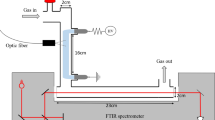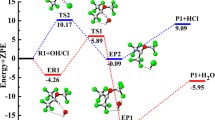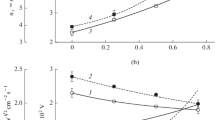Abstract
Elucidation of the CF2 generation mechanism in 1,3-C4F6 gas plasma has been one of the important issues for experimental and theoretical researchers because of the importance of the CF2 radical in plasma etching processes. To determine the direct CF2 fragmentation mechanisms of 1,3-C4F6 in the S0, T1, and cationic D0 states, the reaction geometry, electron transfer, and molecular orbital transformation were investigated by applying the DFT(ɷB97X-D/aVTZ) method. The direct CF2 (S0) formation by C–C double bond rupture of 1,3-C4F6 (S0) proceeds while maintaining the trans-bent structure by dative bonding interaction between CF2 and its counterpart. 1,3-C4F6 (T1) preferentially produces the CFCFCF2 (T1) and CF2 (S0) fragments following a linear reaction course. This process can be explained using a stepwise electron-sharing interaction model. 1,3-C4F6+ (D0) generates a CF2 (S0) radical rather than CF2 (T1) and CF2+ (D0). The CF2 fragmentation process in D0 is also described using the electron-sharing interaction model but proceeds along the trans-rocking pathway, featuring electron oscillations between the CFCFCF2 and CF2 moieties in the C–C distance range of 1.8–2.6 Å. These findings provide insight into CF2 generation of CF2-containing perfluoro-olefins as potential alternatives to c-C4F8 and valuable information to establish the high-reliable 1,3-C4F6 plasma chemistry database essential to plasma simulations.








Similar content being viewed by others
References
Yoon MY, Yeom HJ, Kim JH, Chegal W, Cho YJ, Kwon DC, Jeong JR, Lee HC (2021) Discharge physics and atomic layer etching in Ar/C4F6 inductively coupled plasmas with a radio frequency bias. Phys Plasmas 28:063504
Nakamura S, Itano M, Aoyama H, Shibahara K, Yodoyama S, Hirose M (2003) Comparative studies of perfluorocarbon alternative gas plasmas for contact hole etch. Jpn J Appl Phys 42:5759–5764
Samukawa S, Mukai T (1999) Differences in radical generation due to chemical bonding of gas molecules in a high-density fluorocarbon plasma: Effects of the C=C bond in fluorocarbon gases. J Vac Sci Technol A 17:2463–2466
Hayashi T, Ishikawa K, Sekine M, Hori M, Kono A, Suu K (2011) Dissociation channels of c-C4F8 to CF2 radical in reactive plasma. Jpn J Appl Phys 50:036203
Cobos CJ, Hintzer K, Sölter L, Tellbach E, Thaler A, Troe J (2015) Shock wave study and theoretical modeling of the thermal decomposition of c-C4F8. Phys Chem Chem Phys 17:32219–32224
Suzuki C, Sasaki K, Kadota K (1997) Spatial and temporal variations of CF and radical densities in high-density plasmas studied by laser-induced fluorescence. J Appl Phys 82:5321–5326
Suzuki C, Sasaki K, Kadota K (1998) Surface productions of CF and CF2 radicals in high-density fluorocarbon plasmas. J Vac Sci Technol A 16:2222–2226
Zhang D, Kushner MJ (2000) Mechanisms for CF2 radical generation and loss on surfaces in fluorocarbon plasmas. J Vac Sci Technol A 18:2661–2668
Nakamura M, Hori M, Goto T, Ito M, Ishii N (2001) Spatial distributions of the absolute CF and CF2 radical densities in high-density plasma employing low global warming potential fluorocarbon gases and precursors for film formation. J Vac Sci Technol 19:2134–2141
Carlos JL, Karl RR, Bauer SH (1974) Gas Phase Electron Diffraction Study of Six Fluoroethyleties. J Chem Soc Faraday Trans 2(70):177–187
Hudlicky M, Pavlath AE (1995) Chemistry of organic fluorine compounds II: a critical review. American Chemical Society, Washington, DC
Andrada DM, Casals-Saniz JL, Pendás ÁM, Frenking G (2018) Dative and electron-sharing bonding in C2F4. Chem Eur J 24:9083–9089
Pizzochero M, Bonfanti M, Martinazzo R (2019) To bend or not to bend, the dilemma of multiple bonds. Phys Chem Chem Phys 21:26342–26350
Nakamura T, Motomura H, Tachibana K (2001) Quantum chemical study on decomposition and polymer deposition in perfluorocarbon plasmas: molecular orbital calculations of excited states of perfluorocarbons. Jpn J Appl Phys 40:847–854
Li W-Z, Huang M-B (2003) Equilibrium structures and hyperfine parameters of some fluorinated hydrocarbon radical cations: a DFT B3LYP and MP2 study. J Mol Struct (THEOCHEM) 636:71–79
Brundle CR, Robin MB (1970) Nonplanarity in hexafluorobutadiene as revealed by photoelectron and optical spectroscopy. J Am Chem Soc 92:5550–5555
Wurrey CJ, Bucy WE, Durig JR (1977) Vibrational spectra, structure, and barrier to planarity of perfluoro-1,3-butadiene. J Chem Phys 67:2765–2770
**ao H-Y, Cao J, Liu Y-J, Fang W-H, Tachikawa H, Shiotani M (2007) Structures and cis-to-trans photoisomerization of hexafluoro-1,3-butadiene radical cation: electron spin resonance and computational studies. J Phys Chem A 111:5192–5200
Limão-Vieira P, Anzai K, Kato H, Hoshino M, Ferreira da Silva F, Duflot D, Mogi D, Tanioka T, Tanaka H (2012) Electronic excitation to singlet states of 1,3–C4F6, c-C4F6 and 2–C4F6 by electron impact - electron energy-loss spectroscopy and ab initio calculations. J Phys Chem A 116:10529–10538
Limão-Vieira P, Duflot D, Anzai K, Kato H, Hoshino M, Ferreira da Silva F, Mogi D, Tanioka T, Tanaka H (2013) Studies of low-lying triplet states in 1,3-C4F6, c-C4F6 and 2-C4F6 by electron energy-loss spectroscopy and ab initio calculations. Chem Phys Lett 574:32–36
Chun I, Efremov A, Yeom GY, Kwon KH (2015) A comparative study of CF4/O2/Ar and C4F8/O2/Ar plasmas for dry etching applications. Thin Solid Films 579:136–143
Oh Y, Efremov A, Lee J, Lee J, Choi Y, Kwon KH (2022) Etching kinetics and dielectric properties of SiOC films exposed to Ar and CF4 plasmas. Thin Solid Films 749:139185
Zhang D, Kushner MJ (2001) Investigations of surface reactions during C2F6 plasma etching of SiO2 with equipment and feature scale models. J Vac Sci Technol A 19:524–538
Williams KL, Martin IT, Fisher ER (2002) On the Importance of Ions and Ion-Molecule Reactions to Plasma-Surface Interface Reactions. J Am Soc Mass Spectrom 13:518–529
Wang WZ, Wu Y, Rong MZ, Éhn L, Černušák I (2012) Theoretical computation of thermophysical properties of high-temperature F2, CF4, C2F2, C2F4, C2F6, C3F6 and C3F8 plasmas. J Phys D Appl Phys 45:285201
Tennyson J, Rahimi S, Hill C, Tse L, Vibhakar A, Akello-Egwel D, Brown DB, Dzarasova A, Hamilton JR, Jaksch D, Mohr S, Wren-Little K, Bruckmeier J, Agarwal A, Bartschat K, Bogaerts A, Booth JP, Goeckner MJ, Hassouni K, Itikawa Y, Braams BJ, Krishnakumar E, Laricchiuta A, Mason NJ, Pandey S, Petrovic ZL, Pu YK, Ranjan A, Rauf S, Schulze J, Turner MM, Ventzek P, Whitehead JC, Yoon JS (2017) QDB: a new database of plasma chemistries and reactions. Plasma Sources Sci Technol 26:055014
Chai J-D, Head-Gordon M (2008) Long-range corrected hybrid density functionals with damped atom–atom dispersion corrections. Phys Chem Chem Phys 10:6615–6620
Karpfen A (1999) Torsional potentials of perfluoro-1,3-butadiene and perfluoro-1,3,5-hexatriene: a comparison of ab initio and density functional results. J Phys Chem A 103:2821–2827
Choi H, Park YC, Lee YS, Baeck KK (2013) Density functional theory calculations for simple prototypes of perfluorocarbons: neutral and anionic c-C4F8 and 2-C4F8. J Fluor Chem 146:46–52
Gupta D, Choi H, Kwon D-C, Yoon J-S, Song M-Y (2018) Electron induced ionization of plasma processing gases: C4Fx (x = 1–8) and the isomers of C4F6 and C4F8. J Phys D: Appl Phys 51:155203
Yousaf KE, Peterson KA (2009) Optimized complementary auxiliary basis sets for explicitly correlated methods: aug-cc-pVnZ orbital basis sets. Chem Phys Lett 476:303–307
Chang CH, Andreassen AL, Bauer SH (1971) The molecular structure of perfluorobutyne-2 and perfluorobutadiene-1,3 as studied by gas phase electron diffraction. J Org Chem 36:920–923
Weinhold F, Landis CR (2001) Natural bond orbitals and extensions of localized bonding concepts. Chem Educ Res Pract 2:91–104
Frisch MJ, Trucks GW, Schlegel HB, Scuseria GE, Robb MA, Cheeseman JR, Scalmani G, Barone V, Mennucci B, Petersson GA, Nakatsuji H, Caricato M, Li X, Hratchian HP, Izmaylov AF, Bloino J, Zheng G, Sonnenberg JL, Hada M, Ehara M, Toyota K, Fukuda R, Hasegawa J, Ishida M, Nakajima T, Honda Y, Kitao O, Nakai H, Vreven T, Montgomery JA Jr, Peralta JE, Ogliaro F, Bearpark M, Heyd JJ, Brothers E, Kudin KN, Staroverov VN, Keith T, Kobayashi R, Normand J, Raghavachari K, Rendell A, Burant JC, Iyengar SS, Tomasi J, Cossi M, Rega N, Millam JM, Klene M, Knox JE, Cross JB, Bakken V, Adamo C, Jaramillo J, Gomperts R, Stratmann RE, Yazyev O, Austin AJ, Cammi R, Pomelli C, Ochterski JW, Martin RL, Morokuma K, Zakrzewski VG, Voth GA, Salvador P, Dannenberg JJ, Dapprich S, Daniels AD, Farkas Ö, Foresman JB, Ortiz JV, Cioslowski J, Fox DJ (2013) Gaussian 09, Revision D.01. Gaussian Inc., Wallingford
Barker JR, Nguyen TL, Stanton JF, Aieta C, Ceotto M, Gabas F, Kumar TJD, Li CGL, Lohr LL, Maranzana A, Ortiz NF, Preses JM, Simmie JM, Sonk JA, Stimac PJ (2021) MultiWell-2021 Software Suite. University of Michigan, Ann Arbor, Michigan, USA
Truhlar D (1984) Variational Transition State Theory. Annu Rev Phys Chem 35:159–189
Ali MA, Barker JR (2015) Comparison of Three Isoelectronic Multiple-Well Reaction Systems: OH + CH2O, OH + CH2CH2, and OH + CH2NH. J Phys Chem A 119:7578–7592
Gallaher KL, Yokozeki A, Bauer SH (1974) Reinvestigation of the structure of perfluoroethane by electron diffraction. J Phys Chem 78:2389–2395
Acknowledgements
This research was supported by a National Research Council of Science & Technology (NST) grant by the Korea government (MSIP) (No. CAP-17-02-NFRI) and was also supported by the Korea Institute of Energy Technology Evaluation and Planning (KETEP) and the Ministry of Trade, Industry & Energy (MOTIE) of the Republic of Korea (No. 20202010100020). H.Choi thanks Prof. K.K.Baeck (GWNU) for helpful discussions during the preparation of this paper.
Author information
Authors and Affiliations
Corresponding author
Additional information
Publisher's Note
Springer Nature remains neutral with regard to jurisdictional claims in published maps and institutional affiliations.
Rights and permissions
Springer Nature or its licensor holds exclusive rights to this article under a publishing agreement with the author(s) or other rightsholder(s); author self-archiving of the accepted manuscript version of this article is solely governed by the terms of such publishing agreement and applicable law.
About this article
Cite this article
Choi, H., Park, Y.C., Im, YH. et al. A DFT Study on the Direct CF2 Fragmentation Mechanisms of 1,3-C4F6 and 1,3-C4F6+ in Plasma. Plasma Chem Plasma Process 43, 47–66 (2023). https://doi.org/10.1007/s11090-022-10288-6
Received:
Accepted:
Published:
Issue Date:
DOI: https://doi.org/10.1007/s11090-022-10288-6




